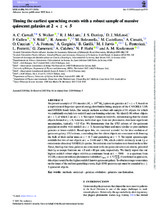| dc.description.abstract | We present a sample of 151 massive (M∗ > 1010 M) quiescent galaxies at 2 <z< 5, based on
a sophisticated Bayesian spectral energy distribution fitting analysis of the CANDELS UDS
and GOODS-South fields. Our sample includes a robust sub-sample of 61 objects for which
we confidently exclude low-redshift and star-forming solutions. We identify 10 robust objects
at z > 3, of which 2 are at z > 4. We report formation redshifts, demonstrating that the oldest
objects formed at z > 6; however, individual ages from our photometric data have significant
uncertainties, typically ∼0.5 Gyr. We demonstrate that the UVJ colours of the quiescent
population evolve with redshift at z > 3, becoming bluer and more similar to post-starburst
galaxies at lower redshift. Based upon this, we construct a model for the time evolution of
quiescent galaxy UVJ colours, concluding that the oldest objects are consistent with forming
the bulk of their stellar mass at z ∼ 6–7 and quenching at z ∼ 5. We report spectroscopic
redshifts for two of our objects at z = 3.440 and 3.396, which exhibit extremely weak Ly α
emission in ultra-deep VANDELS spectra. We calculate star formation rates based on these line
fluxes, finding that these galaxies are consistent with our quiescent selection criteria, provided
their Ly α escape fractions are >3 and >10 per cent, respectively. We finally report that our
highest redshift robust object exhibits a continuum break at λ ∼ 7000 Å in a spectrum from
VUDS, consistent with our photometric redshift of zphot = 4.72+0.06 −0.04. If confirmed as quiescent,
this object would be the highest redshift known quiescent galaxy. To obtain stronger constraints
on the times of the earliest quenching events, high-SNR spectroscopy must be extended to z
3 quiescent objects | en_US |

